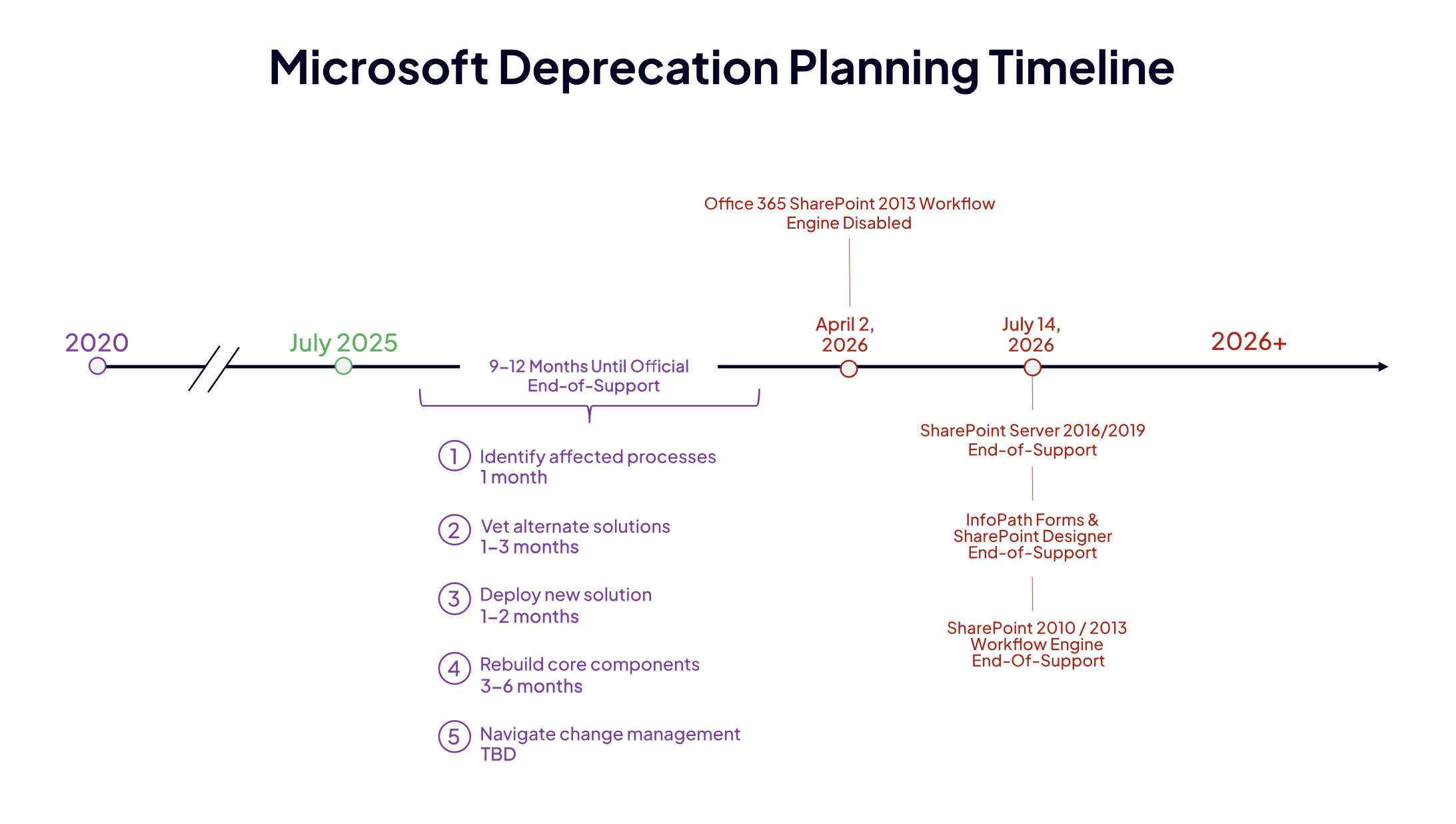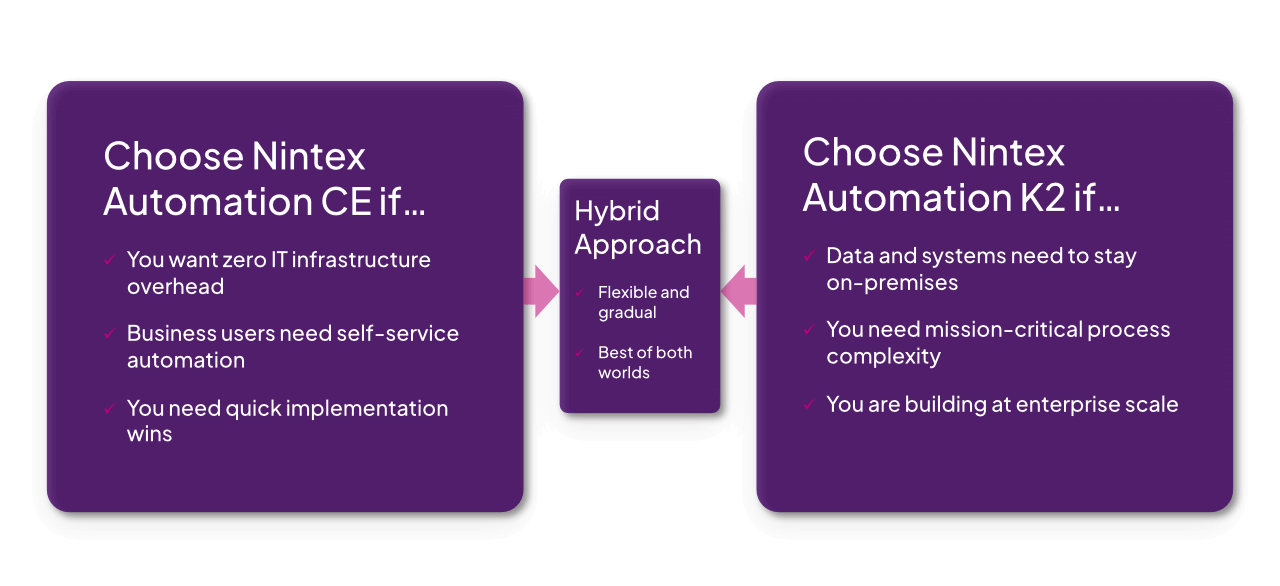Microsoft end of support
SharePoint & InfoPath support ends July 14, 2026
Critical systems need support
Microsoft is discontinuing support for critical business platforms that thousands of organizations depend on daily. These aren’t minor software updates—they represent fundamental shifts that will leave your automation infrastructure exposed and unsupported.
Organizations across industries have built their core business processes on SharePoint workflows and InfoPath forms. From employee onboarding and expense approvals to complex multi-stage project management workflows, these systems handle mission-critical operations. When Microsoft pulls support, these workflows don’t just stop working—they become security vulnerabilities and compliance liabilities.
How Nintex can help
Nintex understands that migration isn’t just about moving workflows from one platform to another. It’s about preserving years of business logic while modernizing your automation capabilities. Our solutions maintain business continuity during transition while unlocking new possibilities for process optimization.
We’ve built our platform architecture around flexibility. Whether regulatory requirements keep you on-premises, cloud economics drive your strategy, or you need to bridge both worlds during a gradual transformation, Nintex provides proven migration paths that protect your investment while positioning you for future growth.
Our approach recognizes that every organization’s automation landscape is unique. Complex approval hierarchies, custom integrations with legacy systems, specialized compliance requirements, and intricate business rules all require careful consideration during migration planning.
Nintex Automation K2 (On-Premises)
Maintain complete control over your environment while modernizing your automation platform. K2 provides enterprise-grade workflows, forms, and integrations designed for complex, regulated environments.
Ideal for:
- Organizations with strict data residency requirements
- Air-gapped or high-security environments
- Complex, non-linear workflow requirements
- Regulated industries requiring full data control
- Large-scale process automation with predictable costs
Nintex Automation CE (Cloud)
Cloud-native platform delivering advanced automation capabilities with continuous innovation, automatic scaling, and zero infrastructure management overhead.
Ideal for:
- Cloud-forward organizational strategies
- Rapid scalability and growth requirements
- Reduced IT overhead and management costs
- Access to latest features and capabilities
- Global collaboration and remote workforce
Hybrid approach
Combine on-premises control with cloud innovation. Start with critical workloads in your preferred environment while gradually modernizing at your own pace. Maintain legacy system integration while piloting cloud capabilities.
Beyond platform migration, Nintex provides the tools and professional services to ensure successful transitions. Our migration utilities help preserve existing business logic while our professional services team guides strategic planning, ensures best practices, and accelerates time-to-value for your new automation environment.
Resources
FAQs
-
Will my SharePoint workflows stop working in 2026?
SharePoint workflows won’t immediately stop functioning after Microsoft’s end-of-support dates, but they become unsupported and vulnerable. Without security patches or bug fixes, these systems face increasing risks of security breaches, system failures, and compliance violations. Most organizations migrate proactively to avoid business disruption.
-
Can I stay on-premises and still migrate my SharePoint workflows effectively?
Yes, on-premises migration is fully supported through solutions like Nintex Automation K2. This approach maintains complete data control, meets strict regulatory requirements, and handles complex workflow scenarios while modernizing your automation platform. Many regulated industries and government organizations choose on-premises migration paths.
-
What are my options when evaluating end-of-support migration solutions?
Primary options include Microsoft Power Platform, third-party automation platforms like Nintex, or custom development. Evaluation factors include deployment flexibility (cloud vs on-premises), workflow complexity support, integration capabilities, total cost of ownership, and migration timeline requirements. Each organization’s needs determine the optimal path.
-
What’s the timeline for planning Microsoft end-of-life and end-of-support migration?
Planning should begin 12-18 months before end-of-support dates. This allows time for discovery, solution evaluation, migration planning, testing, and user training. With SharePoint 2013 workflows ending April 2026 and SharePoint Server 2016/2019 ending July 2026, organizations should start planning immediately to avoid rushed implementations.
-
Can I keep using SharePoint workflows after Microsoft support ends?
Technically yes, but this creates significant business risks. Unsupported systems won’t receive security updates, making them vulnerable to cyberattacks. Compliance frameworks often require supported systems, creating audit risks. System failures won’t have Microsoft support available, potentially causing extended business disruptions.


